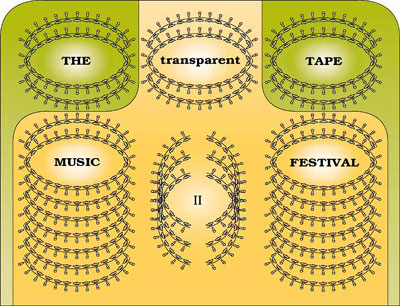Quatre etudes de bruit (1948, 1971 revision) 12'00"
Étude Violette
Étude aux Tourniquets
Étude aux Chemins de Fer
Étude Pathétique
"Having come to the studio to 'make noises speak', I stumbled onto music. . . . Although fragments of words or phrases may be included (like plants may be included in minerals), it goes without saying that they are diverted, if not from their meanings, at least from their use. For lack of music, a sort of sound poetry is thus created ex abrupto."
—P. Schaeffer
Original version— first performance, Concert of Noises, French National Radio, October 5, 1948.
Étude 1— Étude Violette ou Étude au Piano
(Study in Purple or Study for Piano)
Étude Violette illustrates rather brilliantly the process defined by the term "musique concrète". The whole study that we're going to hear has, as its only source, the noises and sounds that can be derived from a piano. Particular attention was paid to excluding all normal ways of playing the piano, not from principle but to make the demonstration more vivid. The composition was based on the "closed groove" technique (creating loops on a phonograph record); it consists of isolating sound fragments or rhythmic figures in different tempos and at different pitches, to be used structurally with different techniques: reverberation, reverse playback, ect.
Étude 2— Déconcertante ou Étude aux Tourniquets
(Deconcertante or Whirligig Study)
The sonic material for this study was provided by exotic and non-exotic thin-metal instruments, wood percussion, and two whirligigs which supply two characteristic musical figures.
A certain abstract organization, suggested by the form of an initial composition by Gaston Litaize, was planned for this study. The techniques used, however, led away from the execution of that plan, which was ultimately considered too brief. The principal themes were played at 333 RPM and a certain number of rhythmic figures were isolated with the intent of creating a fuller orchestration.
Étude 3— Étude aux Chemins de Fer
(Imposed or Railroad Study)
The railroad theme is treated freely in the first part, which contains numerous rhythmic developments. The first part is a bit like a theme and variations; then the second part, still made up of the same elements, moves with determination away from the anecdotal character of the noises. Alt the end, a coda recalls the initial theme.
Étude 4— Étude Pathétique ou Étude aux Casseroles
(Pathétique or Study on Pots and Pans)
After a short opening from one then two rolling boxes, an opposing slow theme brings out a rhythmic leitmotif that continues until the end. Then vocal elements appear, treated in such a basic way as to conserve the same rigorous character in the entire sonic ensemble. After a crescendo sustained by tonal ritornelli, a diminuendo leads to the conclusion, which is given, of course, to a rolling box.
Due to the composer's ignorance of customary action in this situation, he believes that it is indispensable to mention that he is working with voices found on a disc that had been thrown away and where the only identifiable voice is that of the marvelous comedian Sacha Guitry.
Pierre Schaeffer (1910-1995)
is known primarily as the "father of musique concrète", but he was also an excellent writer, pioneer and veteran of radio, and founder and director of many special projects within the French national radio, in particular Le Service de la Recherche (The Research Service) which he directed from 1960 to 1975. Finally, he was a think and research whose ideas had applications in the audiovisual communication and, most directly, in music. His theoretical work is as important as his limited production of music.
After graduating from the Ecole Polytechnique in 1934, Schaeffer started working at Radiodiffusion Française (the French national radio), where, in 1944 he created a studio dedicated to radiophonic training and experimentation. It was in this studio in 1948 that his curiosity led him to "invent" musique concrète.
In 1949, Schaeffer engaged Pierre Henry as his collaborator and worked with Henry in composing several works, among them the well-known Symphony pour un homme seul (Symphony for a man alone), which became the first classic of its genre. In 1951, within the structure of the French national radio, he formed a musical research group that he named Groupe de Recherche de Musique Concrète. In 1958, he formed the Groupe de Recherches Musicales (GRM), which continues today. GRM was at first mobilized to conduct group research into its founder's ideas: The goals were to define a "solfege" (i.e., define the "elements") of the sound universe based on the perception of sound and to question what were clearly false notions about music, listening, timber, sound, etc. Schaeffer's monumental Traité des Objects Musicaux, written in 1966, encompasses the breadth of this research.
Schaeffer's musical production, which was exclusively electroacoustic, consists of a small number of works that were composed during several brief periods of activity. The first series of short compositions, the Études de Bruits (Noise Studies) of 1948, sometimes referred to as the "primitives" of musique concrète, remain as fresh and engaging as when they were first composed. La Flute mexicaine (1949) and L'oiseau RAI (1950) are brief and unpretentious "genre pieces", whereas the curious Suite 14 (1949) seems a serious attempt to reintegrate old music with notes and instruments into a new music based on sound. The seeming lightness, the unpretentious surrealism, and the comic titles of these works scandalized the serialist musicians at the time who were more serious in their musical attitudes. Schaeffer made extensive use of the "closed groove", the equivalent of the later tape loop, and it was on recordable discs that the first pieces of musique concrète were realized.
Schaeffer was a fascinating character, rare, even unique in a musical avant-garde that cultivates, without qualification or nuance, a progressivist optimism. The scruples, the questions, and the skepticism of this "man alone", in a concert of such unanimity, represent a necessary and vital dissonance, a note of anxiety and truth.
—Michel Chion

